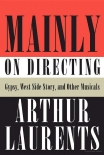Mainly on Directing, Arthur Laurents [best books for students to read TXT] 📗

- Author: Arthur Laurents
Book online «Mainly on Directing, Arthur Laurents [best books for students to read TXT] 📗». Author Arthur Laurents
I always hear her saying that. It's pure Patti LuPone. Other actors wouldn't go straight to that point. As close as we had become, she brought us closer by exposing herself, telling me in effect how to get to her, telling me what she needed to know to play a scene as I wanted, as she wanted, ultimately as we both wanted. That trust was the foundation of an enduring relationship that couldn't be categorized. Working together was and is an endlessly creative joy.
The tone for a song is very often set by a speech leading into the song; the tone for the speech is set before a word is spoken by what's going on inside the character. That's axiomatic, but it's too often ignored.
The second of Rose's big, defining numbers starts with her lead-in speech; the tone for that speech is set by her internal reaction to the letter she is reading on a railway-station bench—a letter from her daughter June, her star, her bread and butter, a letter telling Rose the act was never any good, she was never any good, she isn't needed anymore, she's nothing. At first, Rose is stunned and bewildered; then shock turns to anger and simmers to a boil as she speaks until she is ready to kill. Kill she does, and as she does, her need for revenge right now, this minute, shatters all sense. She goes around the bend and we have a temporarily crazy woman singing and believing “Everything's Coming Up Roses.”
That's how I laid it out for Patti. She had ideas of her own; they were tried, some incorporated, some not. But we knew where Rose had to go and that Patti would get her there. As she warned, she was slow. But once she got it in her gut and in her head, she had both the emotional electricity and the vocal dynamics to make the song chilling and thrill the audience every night so that they screamed as though on cue as the first-act curtain came down.
Even the New York Times was knocked out by the “Roses Turn” she did at City Center. The third and last of Rose's big numbers, it invariably got a huge standing ovation from an audience of over two thousand—from the high-powered in the expensive, uncomfortable orchestra to Patti's fans in the cheaper, equally uncomfortable rear mezzanine and gallery. The last section of the song was particularly overwhelming. Boosted by a series of remarkable lighting effects by Howell Binkley, she tore savagely into those “For me! For me!”s, making a spectacular ending that was a catharsis for everyone. Nevertheless, I thought what she was doing was a collage that didn't really suit her, and that she could do much better; I wanted to do a new “Rose's Turn” for her.
“Rose's Turn” is divided into three sections, the first designed to rock the house by having the star playing Rose shout out “Here she is, boys! Here she is, world! Here's Rose!” as the intro to a down-and-dirty version of a striptease, bumping and grinding as though to the manner born. From Merman on, every Rose scored in that segment, with one exception: Patti LuPone. She was uncomfortable trying to perform a version of the strip as her predecessors, each in her own distinctive style, had done to the delight of the audience wanting to see the equivalent of a star's underwear. There was no style that suited Patti. She was awkward and tentative; she didn't take to choreographed movement, thus she wasn't very good at it—or vice versa. She tried—Patti LuPone will always try—and Bonnie, who never gives up on anyone, smiled and cajoled and encouraged with makeshift adjustments. I put in my two or three cents. A collage, as I said, was the result: more than presentable, and Patti more than just got through the section. But what sufficed at City Center wouldn't at the St. James—not because it was for Broadway but because of what had happened to Patti's Rose.
The new opening kitchen scene feeding a new “Some People” gave Rose new dimensions, as did the new act-ending railway-station speech catapulting her into a furious, frightening new “Everything's Coming Up Roses.” Patti LuPone, star performer, had metamorphosed into a mesmerizing Rose in a dazzling coat of many colors. That was the Rose I wanted in “Rose's Turn.”
We had been doing the number more or less as it always had been done. Why not? It was the landmark eleven o'clock number of musical theatre. I hadn't given a thought to re-examining it as I had every other number in the show. Would I find something new if I did? Something deeper, richer—something Patti could use to make a “Rose's Turn” that was all her own as she had made the other numbers her own?
I also didn't think her City Center “Rose's Turn” was good enough for this new Gypsy we were finding in rehearsal for Broadway, of all places. We sat around the table again, this time in a very streamlined rehearsal studio with big windows overlooking overbulbed and overcrowded Forty-second Street. The show was becoming even more extraordinary for Broadway than it had been at the relatively Off-Broadway City Center. The irony was lost on me, I was too wrapped up in the work, bursting with ideas coming from God knows where or why. Perhaps compensation for the loss of Tom, but the standard Higher Power would only compensate someone in a stratosphere of clouds and feathery wings. I was ninety years old, and maybe I was aging backwards, but my sole memory problem was trying to remember when I last had been so creative.
A visual very often provides my impetus. With “If Momma Was Married,” it





Comments (0)